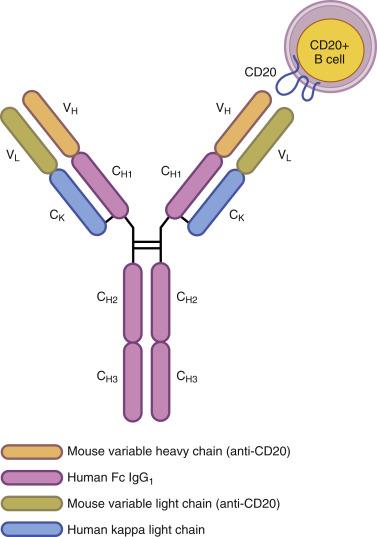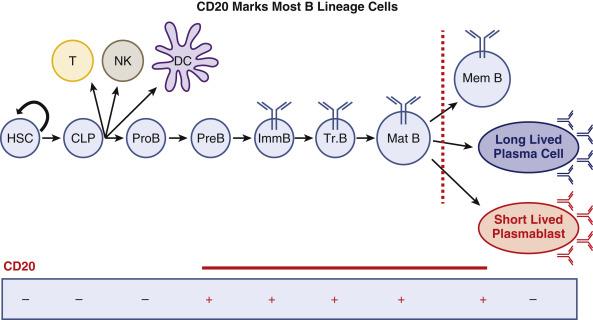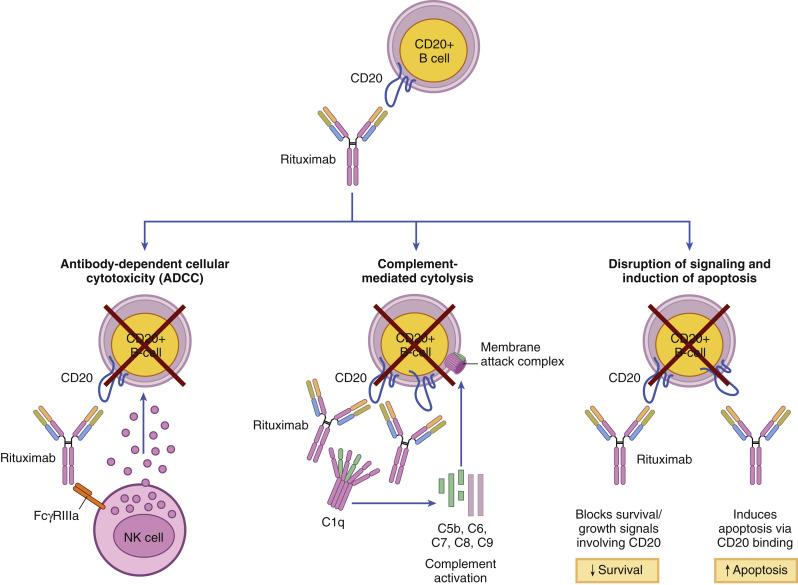Physical Address
304 North Cardinal St.
Dorchester Center, MA 02124
Q30.1 Rituximab is US Food and Drug Administration (FDA) approved for what dermatologic conditions? What are several categories of dermatoses for which off-label use of rituximab has at least some literature support? (Pg. 331x2)
Q30.2 How do the half-lives of endogenous IgG 1 and rituximab compare, and what are some factors that may alter the rituximab half-life? (Pg. 331x2)
Q30.3 Concerning B-cell depletion with rituximab, what is (1) the timing of onset, (2) the average duration of depletion and (3) the timing of recovery? Why are plasma cells spared? (Pg. 331)
Q30.4 What is the mechanism for directly targeting B cells? What are the mechanisms by which B cells are depleted? (Pg. 331x2)
Q30.5 How do the relatively rapid clinical and serologic responses to rituximab in pemphigus help to elucidate which specific B lineage cells produce disease-causing antibody? (Pg. 332x2)
Q30.6 How does rituximab use affect vaccination with live and non-live vaccines? (Pgs. 332, 336)
Q30.7 In addition to depleting pathogenic B cells, what are two ways rituximab indirectly modifies B and T autoimmunity in pemphigus? (Pg. 333x2)
Q30.8 Some clinical studies have observed that the timing and dosing of rituximab treatment in pemphigus may impact the clinical course. What are these studies and what do they suggest? (Pgs. 333, 334)
Q30.9 What is the most common adverse effect from rituximab and what preventative measures reduce this risk? (Pgs. 335, 337)
Q30.10 Rituximab carries Boxed Warnings for reactivation of what two viral infections? (Pg. 336x2)
Q30.11 How common are human antichimeric antibodies to rituximab in lymphoma and autoimmune diseases? What are possible consequences of these antibodies? (Pg. 336)
Q30.12 What are FDA-approved dosing schemes for (1) lymphoma patients, (2) rheumatoid arthritis? (3) granulomatosis with polyangiitis and microscopic polyangiitis and (4) pemphigus vulgaris? (Pg. 336)
Q30.13 What laboratory tests are suggested prior and subsequent to rituximab therapy? (Pg. 337)
Q30.14 What is the name of the rituximab biosimilar? What are its FDA-approved indications? (Pg. 337)
Q30.15 What is the name of a second-generation CD20 monoclonal antibody? How does it differ biologically from rituximab? What is its FDA-approved indication? (Pg. 337)
Antibody
Adverse effects/events
Bullous pemphigoid
Complete blood count
Chinese hamster ovary
Chronic lymphocytic leukemia
Cytomegalovirus
Corticosteroids
Epidermolysis bullosa acquisita
Eosinophilic granulomatosis with polyangiitis
Enzyme-linked immunosorbent assay
Granulomatosis with polyangiitis
Graft-versus-host disease
Human antichimeric antibody
Hepatitis B virus
Intravenous immunoglobulin
John Cunningham virus
Late-onset neutropenia
Microscopic polyangiitis
Primary cutaneous B-cell lymphoma
Pneumocystis pneumonia
Pemphigus foliaceus
Paraneoplastic pemphigus
Pemphigus vulgaris
Rheumatoid arthritis
Systemic lupus erythematosus
In 1997, rituximab became the first monoclonal antibody (Ab) approved by the US Food and Drug Administration (FDA) for the treatment of cancer. Rituximab binds the B cell surface antigen CD20 and triggers B cell depletion. Its first FDA-approved clinical use was for the treatment of CD20+ B cell non-Hodgkin lymphoma (NHL). In following years, its approval extended to use in combination therapy for CD20+ chronic lymphocytic leukemia (CLL), rheumatoid arthritis (RA) unresponsive to other therapies, granulomatosis with polyangiitis (GPA), microscopic polyangiitis (MPA) and in 2018, pemphigus vulgaris (PV).
The first clinical use of rituximab for a dermatologic condition was paraneoplastic pemphigus (PNP), where treatment of the underlying CD20+ follicular NHL with rituximab led to improvement in oral and mucosal pemphigus disease. Rapidly thereafter, came numerous reports of the successful use of rituximab for severe pemphigus, refractory to treatment with systemic corticosteroids (CS) and conventional immunosuppressants. Larger case series then provided further support for the use of rituximab for PV and pemphigus foliaceus (PF). Given the favorable and often durable response to therapy and the observed tolerability compared with conventional treatment, clinicians began asking if rituximab should be used as first-line therapy for pemphigus. Q30.1 In 2017, the results of a randomized trial comparing rituximab plus short-term prednisone, compared with prednisone alone, provided support for this idea and led to FDA approval of rituximab for the treatment of moderate to severe pemphigus.
Q30.1 In addition to PV, numerous case series and reports have documented the off-label use of rituximab in other dermatoses where B cells play roles in pathogenesis ( Box 30.1 ). The most robust data are for the use of rituximab in other autoimmune bullous dermatoses, particularly PF, PNP, epidermolysis bullosa acquisita (EBA), bullous pemphigoid and mucous membrane (cicatricial) pemphigoid. Other disorders include cutaneous lupus erythematosus, graft-versus-host disease (GVHD), dermatomyositis, eosinophilic granulomatosis with polyangiitis (EGPA— formerly known as Churg-Strauss), cryoglobulinemic vasculitis, immunoglobulin (Ig)A vasculitis (Henoch–Schönlein purpura) and cutaneous B cell lymphoma.
Non-Hodgkin B cell lymphoma CD20+
Chronic lymphocytic leukemia CD20+
Rheumatoid arthritis
Granulomatosis with polyangiitis
Microscopic polyangiitis
Pemphigus vulgaris
Autoimmune bullous dermatoses: pemphigus foliaceus, paraneoplastic pemphigus, epidermolysis bullosa acquisita, bullous pemphigoid, mucous membrane pemphigoid
Dermatomyosititis
Cutaneous lupus erythematosus
Graft-versus-host disease
Eosinophilic granulomatosis with polyangiitis
This chapter deals with the pharmacology and clinical use of rituximab. Addressed are the pharmacokinetics, mechanism of action, dosing and potential adverse effects (AE) of rituximab. FDA-labeled and off-label dermatologic indications for rituximab are discussed. The chapter ends with a brief discussion of FDA-approved rituximab biosimilar and second generation anti-CD20 agents.
Rituximab is a 145-kDa chimeric murine-human monoclonal IgG 1 κAb directed against the CD20 antigen expressed on B cells ( Table 30.1 ). The chimeric Ab is comprised of two mouse variable regions that recognize CD20, two human IgG 1 heavy chains, and two human κ light chains ( Fig. 30.1 ). It is manufactured in Chinese hamster ovary (CHO) cells through the use of recombinant DNA technology.
| General information | |||||
|---|---|---|---|---|---|
| Name | How Supplied | Standard Dosage PV | |||
| Rituximab Trade name: Rituxan Manufacturer: Genentech/Biogen Idec |
100 mg/10 mL or 500 mg/50 mL single-use vials | FDA-labeled: 1000 mg IV infusions twice 2 weeks apart in combination with a tapering dose of glucocorticoids, then 500 mg at months 12 and 18 and every 6 months thereafter, as needed or Unlabeled induction and relapse: 375 mg/m 2 IV infusions weekly for 4 weeks Unlabeled maintenance: varying (see text) |
|||
| Immunologic Properties | |||||
| Monoclonal Ab Structure | Target | Infusion Reactions | Antidrug Antibodies | ||
| Monoclonal antibody, chimeric IgG 1 κ 25% mouse, 75% human |
CD20 on the surface of B cells | 60% of PV patients in the Ritux 3 trial. Mostly mild to moderate Grade 1–2 |
56% of PV patients in the Ritux 3 trial (per manufacturer); significance unknown | ||

Q30.2 As a targeted monoclonal Ab, the pharmacokinetics of rituximab are largely influenced by the characteristics of the Ab isotype, as well as the amount and location of its target, CD20. Human IgG 1 antibodies have a half-life of about 21 days in the circulation, and this is within the range of what has been measured for rituximab. Clearance is thought to be primarily through phagocytosis.
A pharmacokinetic analysis of 2005 RA patients, receiving rituximab, determined an estimated clearance of 0.335 L/day, and the volume of distribution was 3.1 L. Q30.2 The mean terminal elimination half-life was 18 days. Because of patient to patient variation in the amount of CD20, especially in the setting of B cell malignancy, the half-life of rituximab can vary dramatically among individuals. In addition, levels of serum rituximab increase with repeated doses, as B cell depletion leads to less and less available CD20 antigen.
Q30.3 Rituximab therapy typically leads to depletion of peripheral blood B cells 2 to 3 weeks after treatment initiation. Depletion of peripheral blood B cells is sustained for 6 months on average, and peripheral blood B cell numbers usually return to normal levels within the first year after treatment. Plasma cells are not depleted and serum Ig levels do not decline markedly.
Age, weight, and gender do not appear to affect rituximab pharmacokinetics. Studies have not evaluated pediatric or adolescent populations or adults with hepatic or renal impairment, but dosing adjustments are not generally recommended.
Q30.4 Rituximab is a chimeric monoclonal Ab that binds to CD20 on the surface of CD20+ B cells and induces their depletion. CD20 is a cell-surface antigen expressed nearly exclusively on B cells, beginning at the pre-B cell stage of development, and continuing on to mature, activated and memory B cells. Hematopoietic stem cells, pro-B cells, short-lived plasmablasts and long-lived plasma cells do not express CD20, and thus are not directly affected by rituximab. Short-lived plasmablasts are indirectly depleted, as their CD20+ progenitors are targeted ( Fig. 30.2 ).

Q30.4 Rituximab depletes B cells through three known mechanisms ( Fig. 30.3 ):
Ab-dependent cellular cytotoxicity. Immune effector cells expressing Fcγ receptors, particularly natural killer cells, bind CD20+ cells coated with the IgG 1 isotype rituximab Ab. Upon receptor binding, effector cells secrete cytotoxic granules and kill CD20+ B cell via cytolysis.
Complement-mediated cytolysis. Binding of rituximab to CD20 allows for the activation of the classical complement pathway, resulting in insertion of the membrane attack complex into the plasma membrane and the induction cell death.
Signaling induced cell death. Rituximab binding can also induce CD20 signaling and promote cell death. Although incompletely understood, such signaling may involve alterations in p38 mitogen-activated protein kinase (MAPK), nuclear factor(NF)-κB, extracellular signal regulated kinase (ERK) 1/2 and protein kinase B (AKT) pathways.

Q30.5 Effect of rituximab on pre-existing immunity. Much of acquired immunity to infectious disease, induced by immunization or natural infection, is maintained by standing Ab titers generated by long-lived plasma cells. Plasma cells are CD20– and are not directly targeted by rituximab. Thus, rituximab spares much of the immunity a recipient has acquired over his or her lifetime. Indeed, multiple studies have shown that after rituximab treatment, individuals retain grossly normal serum titers of Ab to pneumococcus, tetanus toxoid, and varicella zoster virus.
Q30.6 Effect of rituximab on the formation of new immunity. New B cells are continually generated in the bone marrow and enter into the blood, lymphatics, spleen and peripheral tissues to surveil for infectious agents. Although rituximab depletes the bulk of the B cell pool, CD20 − hematopoietic cells, common lymphoid precursors and pro-B cells are spared. Thus, after rituximab treatment is completed and the drug itself is catabolized, the B cell compartment regenerates. New immune responses to vaccines and infections are impaired for a time but are eventually restored. As early as 4 months postrituximab, autoimmune blistering disorder patients have been observed to mount grossly normal responses to influenza vaccination. Although the investigators favor that the influenza response are mounted by memory B cells, not depleted by rituximab, rather than newly generated naïve B cells, this observation highlights the potential of the B cell response to recover postrituximab.
Q30.5 Effect of rituximab on pathogenic autoimmunity. In pemphigus, rituximab depletes pathogenic antidesmoglein-specific CD20+ B cells. The high serum and tissue titers of antidesmoglein antibodies characteristic of active pemphigus are produced by short-lived plasmablasts. These pathogenic plasmablasts are indirectly depleted when rituximab depletes their direct CD20+ B cell precursors. Before the clinical use of rituximab for pemphigus, it was unknown if long-lived plasma cells or short-lived plasmablasts were responsible for generating disease-inducing Ab. When clinical improvement and reduction in antidesmoglein Ab titers were observed in the first months after rituximab, it became clear that short-lived plasmablasts were the primary drivers of disease.
Q30.7 In addition to the decline of circulating autoreactive B cells and their corresponding Ab, B cell depletion by rituximab leads to secondary effects on the immune system. Studies have noted decreased costimulatory molecules on CD4+ T cells, decreased numbers of memory T cells and increased numbers of regulatory T cells. In pemphigus, rituximab therapy results in a decrease in desmoglein reactive CD4+ T cells. In patients who achieve complete remission postrituximab, an expanded interleukin (IL)-10-producing B regulatory cell compartment has been observed. Together these observations indicate that rituximab therapy indirectly triggers immunomodulatory effects beyond the direct depletion of pathogenic B cells.
Durability of the antiautoimmune response. In pemphigus, most patients treated with a single cycle of rituximab achieve remission but subsequently relapse, although a minority achieve durable remission off all therapy. Q30.8 Experimental data suggest that recurrent disease is mediated by residual clones, identical in specificity to those present at disease onset. Further, pathogenic clones are few in number and new clones are rarely observed over the disease course. These data suggest that success of rituximab therapy hinges on effective elimination of a small group of CD20+ antidesmoglein B cell clones. These findings complement and extend clinical observations described earlier and suggest that rituximab initiation, early in disease course and with higher and repeated dosing, may result in a more favorable and durable response.
Q30.7 Rituximab is FDA approved for the treatment of NHL, CLL, refractory RA, GPA, MPA and moderate to severe PV (see Box 30.1 ).
The effective use of rituximab for pemphigus-related disorders was first documented in reports of individuals with B cell lymphomas and severe treatment refractory PNP. Next came case reports and case series documenting the effective use of rituximab in over 400 patients with severe PV and PF, refractory to treatment with high dose CS and conventional immunosuppressive drugs.
In 2017, the first randomized trial of rituximab for PV and PF was published This prospective, multicenter, parallel group, open-label study compared efficacy and AE in 90 newly-diagnosed patients randomized to first-line treatment with rituximab plus short-term prednisone versus prednisone alone. Patients received either (a) rituximab 1000 mg on days 0 and 14 and 500 mg at months 12 and 18, in combination with prednisone 0.5 or 1.0 mg/kg daily, tapered over 3 or 6 months or (b) prednisone 1.0 or 1.5 mg/kg daily tapered, over 12 or 18 months alone. Patients were followed for 36 months. By 24 months, the rate of remission off therapy was nearly 3 times higher and the AE about half as many among those in the rituximab plus short-term prednisone group compared with those in prednisone alone. This study provides the strongest data to date supporting rituximab as first-line therapy for PV and PF. Further, it served as rationale for FDA labeling of rituximab for moderate to severe pemphigus.
Remission of pemphigus after a single cycle of rituximab lasts on average 1-year. Some individuals do not clear completely after a single cycle and require repeat cycles of rituximab, with or without adjuvant CS and immunosuppressants. Occasional individuals remain in complete remission off therapy for many years, or indefinitely, but the majority require maintenance therapy. The optimal maintenance regimen is unclear. In the Ritux 3 trial, patients were treated empirically at months 12 and 18 with 500 mg (the FDA dosing) and 89% were in complete remission off therapy at 24 months.
Clinical improvement generally correlates with a decrease in desmoglein-reactive IgG autoantibody levels, and, conversely, relapse with a rise in titer. Thus trending of these titers by (enzyme-linked immunosorbent assay) ELISA is a useful clinical monitoring tool. However, the correlation of disease activity and Ab titer is not absolute and some patients improve clinically, despite persistent desmoglein Ab titers, consistent with the fact that not all antidesmoglein antibodies are pathogenic.
Q30.8 When relapse occurs postrituximab, available evidence indicates that the offending Ab is derived from the same B cell clones as pre-rituximab, suggesting that incomplete deletion of pathogenic B cells is at least in part responsible for relapse. Some clinical studies suggest that treatment with rituximab, later in disease and at lower doses, is more likely to result in sooner relapse, and conversely that treatment, early and more frequent treatment, is correlated with faster remission. Together, these findings hint that initiation of rituximab early in disease course and at higher dose may be most effective for the treatment of PV. Randomized controlled studies will be needed to clearly delineate these questions.
Rituximab therapy plays a key role in the induction and maintenance treatment of the antineutrophil cytoplasmic antibodies–associated vasculitides. Rituximab in combination with CS is the only FDA-approved treatment for GPA and MPA.
Rituximab has been used off-label for several dermatologic conditions, in which B cells play a role in disease pathogenesis (see Box 30.1 ). Experience for these indications is summarized subsequently.
The majority of studies examining the efficacy of rituximab in the treatment of pemphigus combined patients with PV and PF. Thus, the studies detailing the experience in PF are described earlier. In these studies, including larger case series and the randomized trial, patients with PF were treated and evaluated in the same manner as those with PV and appeared to respond similarly. However, unlike PV, PF is an off-label indication for rituximab.
Although there are no prospective trials evaluating the use of rituximab in bullous pemphigoid, there are ample studies justifying its use. In these studies, complete remission (on or off other therapy) occurred in 57% to 100% of patients treated with rituximab. Patients were treated with the rituximab 375 mg/m 2 weekly for 4 doses or, in one study, 500 mg per week for 4 weeks. When documented, mean time to clinical improvement was 4 months. Relapses after complete remission off therapy occurred after about 6 months and were reportedly mild and easily managed. Notably, all rituximab treated patients from these studies had at least a partial response and several had disease and treatment-free remissions extending beyond 2 years.
Become a Clinical Tree membership for Full access and enjoy Unlimited articles
If you are a member. Log in here